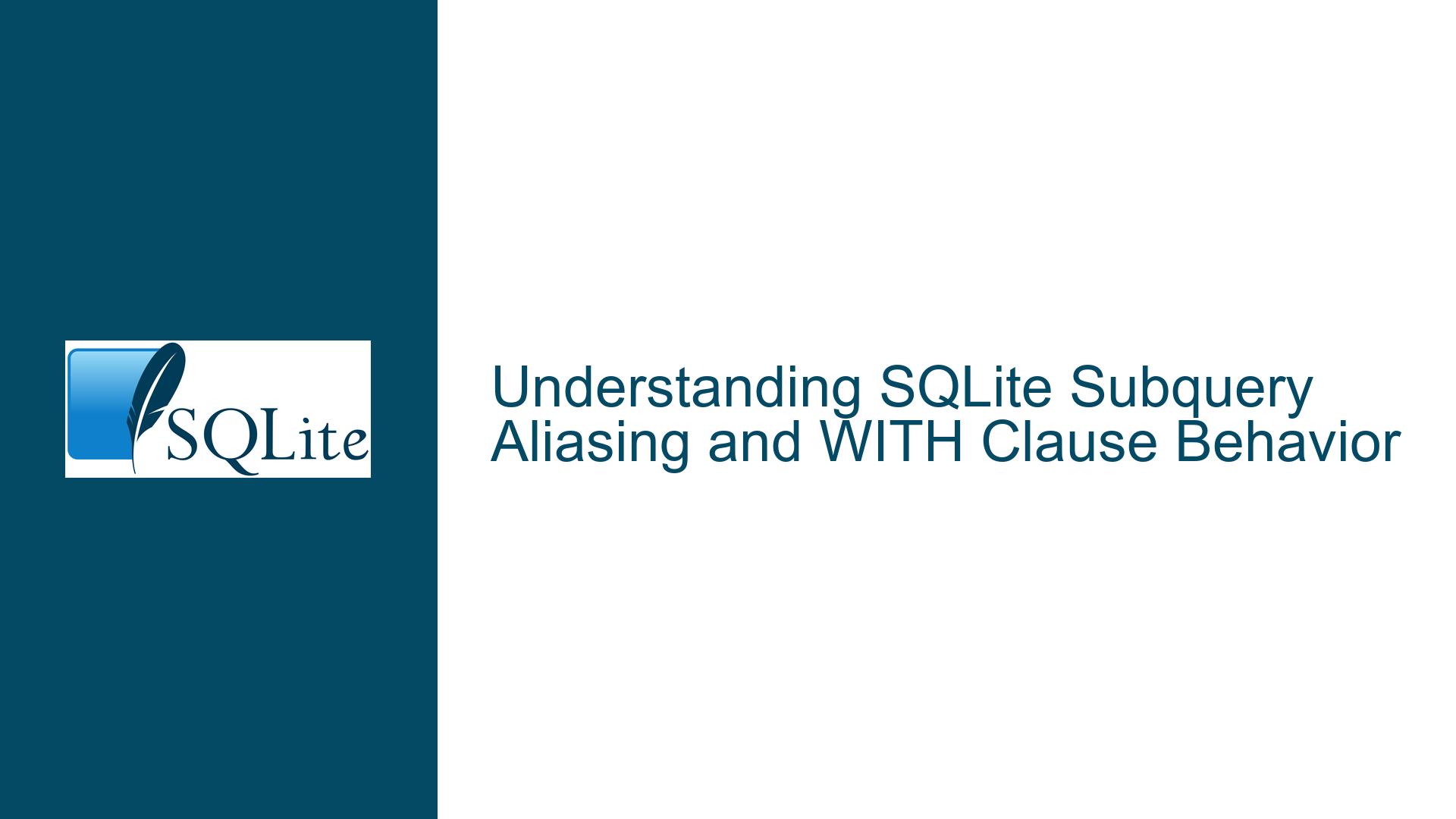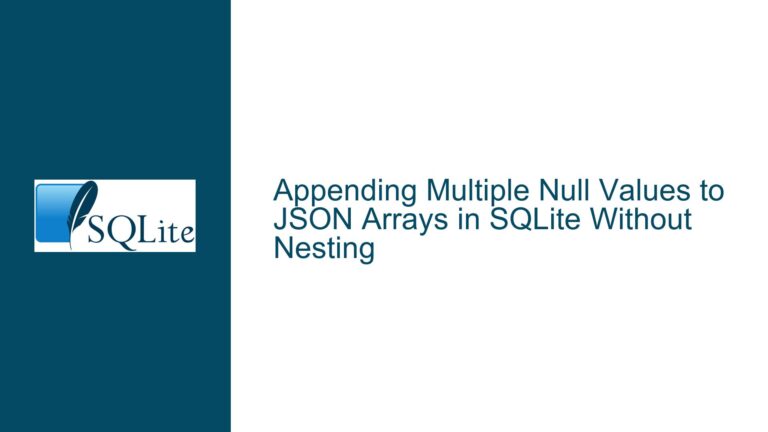SQLite Subquery Aliasing and WITH Clause Behavior
Issue Overview: Subquery Aliasing in FROM Clause vs. WITH Clause
The core issue revolves around the recognition of table aliases in SQLite when using subqueries in the FROM clause versus the WITH clause. Specifically, the problem arises when a subquery is aliased within the FROM clause, and the alias is not recognized in subsequent parts of the query, leading to a "Parse error: no such table" error. Conversely, when the same subquery is encapsulated within a WITH clause, the alias is recognized, and the query executes successfully.
The query in question involves a complex JSON construction that relies on data from a subquery. The subquery generates a set of rows with calculated fields, including a row number (idx), a JSON object (data), and a title (trk_title). The main query then uses this subquery to construct a JSON object based on certain conditions. The failure occurs when the subquery is placed directly in the FROM clause with an alias, but works when the same subquery is defined in a WITH clause.
Possible Causes: Scope and Lifetime of Subquery Aliases
The discrepancy in behavior between the two approaches can be attributed to the scope and lifetime of the subquery aliases in SQLite. When a subquery is defined in the FROM clause, its alias is only valid within the context of that specific FROM clause. This means that any reference to the alias outside of the FROM clause, such as in the SELECT or WHERE clauses, will result in an error because the alias is out of scope.
On the other hand, when a subquery is defined in a WITH clause, the alias is treated as a Common Table Expression (CTE). CTEs have a broader scope and are recognized throughout the entire query, including in subsequent SELECT, WHERE, and other clauses. This is why the alias t is recognized in the WITH clause version of the query but not in the FROM clause version.
Another factor to consider is the order of evaluation in SQLite. When a subquery is in the FROM clause, it is evaluated as part of the FROM clause’s execution. Any references to the alias outside of this context are not valid because the alias does not exist in the outer scope. In contrast, a CTE defined in a WITH clause is evaluated before the main query, and its result set is available for the entire query, making the alias accessible in all parts of the query.
Troubleshooting Steps, Solutions & Fixes: Ensuring Proper Scope and Lifetime of Aliases
To resolve the issue, it is essential to understand the scope and lifetime of subquery aliases in SQLite and to structure the query accordingly. Here are the steps to troubleshoot and fix the problem:
Identify the Scope of the Alias: Determine where the alias is being referenced in the query. If the alias is referenced outside of the FROM clause, it will not be recognized, and the query will fail. In the provided query, the alias
tis referenced in the SELECT clause, which is outside the scope of the FROM clause subquery.Use WITH Clause for Broader Scope: If the alias needs to be referenced in multiple parts of the query, such as in the SELECT, WHERE, or other clauses, use a WITH clause to define the subquery. This ensures that the alias is recognized throughout the entire query. The WITH clause version of the query works because the alias
tis defined as a CTE and is available in the SELECT clause.Rewrite the Query Using WITH Clause: Convert the subquery in the FROM clause to a CTE in a WITH clause. This involves moving the subquery definition to the beginning of the query and giving it a name using the WITH clause. The main query can then reference this CTE by its alias. This approach ensures that the alias is recognized in all parts of the query.
Avoid Nested Subqueries in FROM Clause: If the query logic requires multiple levels of nesting, consider breaking it down into multiple CTEs using the WITH clause. This not only makes the query more readable but also ensures that aliases are recognized in all parts of the query. Each CTE can be defined with its own alias, and the main query can reference these aliases as needed.
Test the Query with Sample Data: After rewriting the query using the WITH clause, test it with sample data to ensure that it produces the expected results. This step is crucial to verify that the query logic is correct and that the alias is being recognized as intended.
Optimize the Query for Performance: While the WITH clause provides a broader scope for aliases, it is also important to consider the performance implications. CTEs are evaluated before the main query, and their result sets are stored in memory. For large datasets, this can lead to increased memory usage and slower query execution. If performance is a concern, consider optimizing the query by reducing the number of CTEs or by using indexes on the underlying tables.
Document the Query Structure: Once the query is working as expected, document its structure and the rationale behind using the WITH clause. This documentation will be useful for future maintenance and for other developers who may need to understand or modify the query.
By following these steps, you can ensure that the alias is recognized throughout the query and avoid the "Parse error: no such table" error. The key is to understand the scope and lifetime of subquery aliases in SQLite and to structure the query accordingly. Using the WITH clause for subqueries that need to be referenced in multiple parts of the query is a best practice that can help avoid such issues and make the query more readable and maintainable.
Detailed Explanation of the Query Structure
To further understand the issue, let’s break down the query structure and analyze how the alias t is used in both versions of the query.
FROM Clause Subquery Version
In the FROM clause version, the subquery is defined as follows:
from
(
select
(row_number() over win_1 - 1) as idx,
doc_id,
json_object(
'doc_id', doc_id,
'start_min', start_min,
'start_sec', start_sec,
'stop_min', stop_min,
'stop_sec', stop_sec
) as data,
case when start_min = -1 then
'Full Track'
else
ifnull(title,'Untitled')
end as trk_title
from
audio_timeline_docmaps
where
track_id = :track_id
window
win_1 as (order by start_min, start_sec, stop_min, stop_sec)
order by
start_min,
start_sec,
stop_min,
stop_sec
) t
;
The subquery generates a result set with columns idx, doc_id, data, and trk_title. The alias t is assigned to this result set. However, the alias t is only valid within the context of the FROM clause. When the main query attempts to reference t in the SELECT clause, it results in a "Parse error: no such table: t" because the alias is out of scope.
WITH Clause Version
In the WITH clause version, the subquery is defined as follows:
with
t as
(
select
(row_number() over win_1 - 1) as idx,
doc_id,
json_object(
'doc_id', doc_id,
'start_min', start_min,
'start_sec', start_sec,
'stop_min', stop_min,
'stop_sec', stop_sec
) as data,
case when start_min = -1 then
'Full Track'
else
ifnull(title,'Untitled')
end as trk_title
from
audio_timeline_docmaps
where
track_id = :track_id
window
win_1 as (order by start_min, start_sec, stop_min, stop_sec)
order by
start_min,
start_sec,
stop_min,
stop_sec
)
select
case when :reqType is null or :reqType <> 'create' then
json_object(
'rv', 0,
'id', cast(:id as integer),
'req', 'settle',
'data', json_object(
'segments', json_group_array( json(data) ),
'html', group_concat(
'<div class="selection" data-i="'
|| idx || '">' || trk_title || '</div>'
,'')
)
)
else
json_object(
'listIndex', (select idx from t where doc_id = :doc_id_i),
'segments', json_group_array( json(data) ),
'html', group_concat(
'<div class="selection" data-i="'
|| idx || '">' || trk_title || '</div>'
,'')
)
end
from t
;
In this version, the subquery is defined as a CTE with the alias t. The CTE is evaluated before the main query, and its result set is available for the entire query. This allows the main query to reference t in the SELECT clause without any issues. The alias t is recognized throughout the query, and the query executes successfully.
Conclusion
The key takeaway is that the scope and lifetime of subquery aliases in SQLite are critical to understanding why the FROM clause version of the query fails while the WITH clause version succeeds. By using the WITH clause to define subqueries that need to be referenced in multiple parts of the query, you can ensure that the alias is recognized and avoid errors related to unrecognized table aliases. This approach not only resolves the immediate issue but also makes the query more readable and maintainable.






